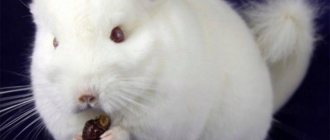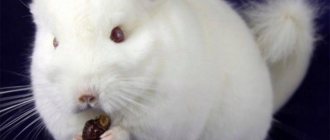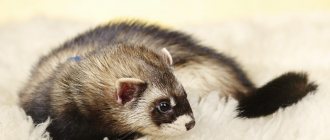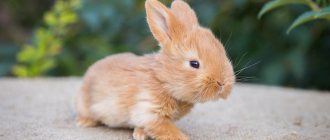03/24/2021 11,445 Chinchillas
Author: Olga
So that the chinchilla could survive in its natural habitat, nature gave it fur of modest colors. The most recognizable color of a chinchilla's coat is white on the tummy, gray on the back and sides. This is the basic color, the so-called standard. Shades from light ash to graphite are the framework within which this gray classic is designed. The breeders decided to change the scenario of nature and the chinchillas themselves, as they were a century ago.
[Hide]
One is gray, the other is white - colors
Experiments on crossing individuals have been ongoing for several decades in order to obtain skins of extraordinary beauty. The result of this work was such new shades as violet, diamond, sapphire, ebony...
Let's figure out exactly what shades these and other, no less spectacular, names encode. Let's find out who the degu and the Siberian chinchilla are. Does Siberian coloring even exist? What does the color of a degu look like? But before we answer these questions, let's talk about the basic gray color.
Strictly speaking, what we call “gray”, meaning the color of a wild rodent, is actually a more complex, three-color color. Just imagine a hair pigmented from tip to root with black, white and gray. It is very difficult to notice the zonality of coloring, because these hairs are located extremely close to each other.
The three-level coloring of the hairs, invisible to the eye, creates an amazing optical effect. – Depending on the depth of black, the purity of white and the shade of gray, the result is fur colored gray with varying degrees of intensity.
The highlight of the color is the silver tint or the so-called veil. These are the short-tailed chinchilla and the long-tailed chinchilla. – This is the name of two species of rodents of the chinchilla family. And the colors that these chinchilla breeds have in nature are standard.
The standard color has four types. Each type corresponds to the degree of color saturation: moderately dark standard, dark standard, extra-dark standard and medium standard. The most valuable is considered to be an individual of the extra-dark standard color.
The restrained beauty of the wild chinchilla is challenged by its domesticated relatives. They are expanding the number of species of rodents in the chinchilla family. And belonging to one or another depends not on the length of the tail, but on the color.
Popular colors of chinchillas
So, today many individuals of various stripes have been bred, the most popular of which are:
- White Wilson. Wilsons have several types: from milky to dark silver. All Wilsons have black eyes and a white tail tip. Two white Wilsons are not planted because two Wilsons have little chance of producing viable young.
- Pastel. Varieties of colors: light pastel, dark pastel, extra-dark pastel, medium pastel. Pastel colored animals darken with age.
- Black velvet. These animals have a white belly, black back and sides. The muzzle of the animal Black Velvet is also black. The more clearly the color contrast is manifested, the higher the individual is valued. Wilsons are often chosen as a pair for Black Velvet. And like the Wilsons, two Black Velvets are not planted together.
- Ebony. The ebony gene affects the degree of coloration of the tummy. If the animal's belly fur matches the color of its main fur, then it is real ebony.
- Homobeige. Homobeige fur is distinguished by uniform coloring. Homobeige animals have pink ears.
- Heterobeige. Unlike homobeige, heterobeige coats are colored unevenly: the tips of the hairs, like the undercoat, are darker than the main tone.
- Degu. Degu is a dwarf chinchilla. In nature, degus “wear” brown fur coats with a yellowish or grayish tint. It doesn't sound as impressive as, say, sapphire and diamond. And it doesn’t look as radical as, for example, an albino. However, breeders liked the small degu chinchillas. They try to recreate the degu color by crossing individuals of different colors.
Possible variations that result from crossing
When crossing animals of different colors, different colors are obtained. The number of possible options is so large that it is simply impossible to list them. Among them are White Velvet, Heteroebony, Homoebony and others.
Rare and spectacular chinchilla colors
Rare colors of rodents of the chinchilla family are:
- Sapphire. A blue chinchilla with a pearly white belly and pink ears: meet Sapphire. Individuals of the Sapphire color have low viability, so they are rare in their pure form.
- Royal Persian Angora. This is a long-tailed chinchilla, whose colors can be any. The most valuable types of Royal Persian Angoras are diamond and sapphire. The “royal” feature of Angoras is their long, beautiful hair. Thanks to their rich wool, Royal Angoras, even of standard color, look luxurious.
- White and pink coats belong to animals with beige and white genes. These genes make themselves felt in different ways, which is why there are several subspecies of pink and white colors. So, the white-pink color is both white, with beige marks, and beige, with white spots. But no matter what subspecies the white-pink color is classified as, the color of its owner’s ears will always be pink. To produce pink and white cubs, both the female and the male must be carriers of four genes at once. This is why white and pink colors are not common. Breeders really like individuals of this color, because the white and pink shade has a royal look!
- Violet. Animals of this color do not always have purple fur. The fur coat can be gray or purple. But a shade of violet is always present in the pigmentation of the nose. In order not to lose the violet gene, violet-colored individuals are planted exclusively with each other. However, sometimes breeders deviate from this rule, breeding individuals in shades of violet and black velvet.
So who is the Siberian chinchilla? Having listed a large number of colors, we still haven’t met the Siberian. It turns out that the Siberian chinchilla is a breed of cat. Attempts to find a “Siberian” shade (or anything else “Siberian”) in rodents of the chinchilla family are in vain.
But Siberian cats “borrowed” their zone-colored hairs from rodents. The surprisingly soft fur of Siberian cats added similarity to animals from different orders.
Other breeds
There are many more breeds of chinchillas - for every taste and color. The following varieties are most often found in Russian nurseries:
- Silver Mosaic is a hybrid of a white chinchilla and a standard breed. It is distinguished by white fur with numerous gray patches. From a distance, the fur of representatives of this breed appears pearly.
- White mosaic - similar to the previous breed, but the white and gray areas have clearer outlines.
- Violet is a very rare variety. Breeding is complicated by late puberty. Animals are ready to mate only from the age of one and a half years. They have a light lilac back and a white belly. The face and ears are a more saturated purple hue.
- White and pink diamond . It is distinguished by light fur with a pink tint. Ears, nose and paws are pale pink. It is worth noting that the genotype of representatives of this breed also contains a lethal gene. Therefore, they are only allowed to be crossed with chinchillas of other varieties.
- Sapphire is one of the most beautiful and expensive rocks. The fur coat has a gray-blue tint, the tummy is pale blue. The ears are pale pink. The look is complemented by large beady eyes. It is better to buy representatives of this breed after reaching 7-8 months, since it is at this age that the formation of coat color ends.
- Blue diamond - distinguished by a fur coat of a rich gray-blue hue with a metallic tint. There is a dark ornate pattern running along the spine.
It is worth noting that there are so many chinchilla breeds that in search of the rarest and most beautiful, novice breeders simply begin to get confused. For example, some are trying to find the elusive Siberian chinchilla. And absolutely in vain. Because in fact, this is one of the long-haired cat breeds.
Genetic color calculator for chinchillas
The colors of chinchillas are very diverse. How to breed an individual of the desired color? Understanding the complex interweaving of pet genes can be quite difficult. A tool such as a genetic calculator comes to the aid of a chinchilla breeder. Using a genetic calculator, you can determine which color offspring is most likely to be born.
So, using this calculator, you can calculate that a Homoebony mother and a Homoebony dad will have almost 64% probability of producing Gomoebony cubs. There is a 22% chance that their babies will have the Extra-Dark Ebony color. The possibility of these parents having Ebony-dark babies is 10%. And in only 4% of cases, such a couple gives birth to Ebony-light and Ebony-medium cubs.
Animals with beige fur
The main shade of these rodents is pastel. However, it has several variations. In addition, the older the chinchilla, the darker its fur will be. It can be brown, red or beige. This type of rodent can be transverse.
Homobeige
This type of rodent has uniformly colored light beige fur and pink ears. Single dark hair is allowed in this shade.
Heterobeige
These rodents, on the other hand, have irregular colors. The entire coat is beige, the undercoat and tips of the hair are brown. When choosing a chinchilla, pay attention to the color difference between the rest of the body and the belly.
Beige tower
The fur color of these animals ranges from light to dark beige, which is paired with a brown pattern along the spine.
Brown velvet
The main color of the fur of these animals is beige, with a chocolate-colored back and head, and a sand-colored belly.
Wellman beige
The chinchilla has light beige fur, light ears and dark eyes.
Beige Sullivan
These rodents have rich beige fur and red eyes.
Video “Chinchilla colors”
This video features White and Pink Chinchilla, Angora Chinchilla, Beige Chinchilla, White Wilson. Here you can also see individuals of such colors as Brown Velvet, Homoebony, Homobeige, White Velvet, White Sapphire. The authors of the video also did not forget about the colors Albino, White Violet, Blue Diamond, Pastel, Ebony, Violet, Homobeige Sapphire, Sapphire, Black Velvet.
Was this article helpful?
Thank you for your opinion!
The article was useful. Please share the information with your friends.
Yes (75.00%)
No (25.00%)
X
Please write what is wrong and leave recommendations on the article
Cancel reply
Rate the benefit of the article: Rate the author ( 5 votes, average: 4.80 out of 5)
Discuss the article:
Which breed is better to choose?
There are no clear recommendations regarding which breed of chinchilla is best to choose. This comes down to personal preference:
- lovers of furry pets should prefer the Angora breed;
- those who prefer miniature animals will like dwarf chinchillas;
- breeders who are crazy about rare exclusive breeds should pay attention to the violet, blue or pink diamond;
- Ebony chinchillas are ideal for professional breeders attending exhibitions;
- For those who do not want to spend money on purchasing a rare breed pet, it is better to pay attention to the standard.
The main thing to consider when choosing is the health of the animal. And both physical and psychological. If the animal is active, shows curiosity, has shiny fur without bald spots, everything is fine.
If the fluffy hid in the corner of the cage, or, conversely, shows aggression, it is better to go shopping to another nursery. Signs such as runny nose and eyes, dull fur, bad breath, and rotten teeth may also indicate an animal’s illness.
Regardless of the breed, any chinchilla needs the care and love of its owner. Only by feeling the warm attitude of the owner and living in good conditions, the pet will feel comfortable and confident. And most importantly, he will reciprocate the owner’s gratitude.
Where do chinchillas live?
The habitat of rodents is the Andes mountain system in South America at an altitude of 400 to 5000 m; they are adapted to life in the mountains. Their skeletons compress vertically, allowing the animals to crawl through narrow vertical cracks. A well-developed cerebellum allows the animals to move perfectly on rocks. Large black eyes, long whiskers - vibrissae, large oval ears - are not an accident - this is an adaptation to a twilight lifestyle. With the help of these devices, the rodent sees well and hunts at night. When a threat approaches, they attack, stand on their hind legs and can bite with their teeth.
Chinchilla - pros and cons
White Pannon rabbit: description, breeding and care
Despite the fact that interest in keeping chinchillas at home is constantly growing, it is safe to say that they will never really compete with cats and dogs as the most popular pets. Due to their natural characteristics, and also due to the fact that, unlike the mentioned cats and dogs, they have not gone through the millennia-long path of adaptation to life next to humans, ChinchillasChinchilla is a rodent from the chinchilla family, externally similar to something in between... they cannot become a full-fledged “four-legged friend.” But they are quite suitable for the role of a decorative pet.
So, here are a few reasons why you should or, on the contrary, should not:
- ChinchillasChinchilla is a rodent from the chinchilla family, outwardly similar to something average m... they feel great in a human home if basic living conditions are created for them - a suitable size cage for ChinchillaChinchilla is a rodent from the chinchilla family, outwardly similar to something average m..., normal nutrition, etc.
- These animals do not naturally have an unpleasant odor. Even the natural secretions of chinchillas have almost no smell. If there is always enough hay in the cage, then the animal’s fur will produce hay.
- Chinchillas A chinchilla is a rodent from the chinchilla family, outwardly similar to something in between... they have a very kind disposition and, in general, are not inclined to show aggression even towards strangers. Guests can always be offered to hold the chinchilla without the slightest risk and take a photo with it in their arms.
- Chinchillas A chinchilla is a rodent from the chinchilla family, outwardly similar to something in between m... very smart, can follow some commands and respond to its nickname.
- Don't be surprised when you find out how long Chinchillas live. A chinchilla is a rodent from the chinchilla family that looks like something in between... When you get a pet, you don’t have to worry that it will die and thereby break your child’s heart.
- Chinchillas A chinchilla is a rodent from the chinchilla family, outwardly similar to something in between... They combine very beautiful fur with a rather stupid expression on their muzzle, which makes them so charming.
"Against":
- These are nocturnal animals that run around the Chinchilla's cage all night long. The Chinchilla is a rodent from the chinchilla family, outwardly similar to something in between m..., they gnaw something, rustle and generally make quite a lot of noise. In view of this, ChinchillasChinchilla is a rodent from the chinchilla family, outwardly similar to something in between... not suitable for those who have very sensitive sleep and do not have the opportunity to put the cage in another room.
- Chinchillas A chinchilla is a rodent from the chinchilla family, which looks like something in between m... can only swim in sand, which inevitably scatters around the “bathroom”, which is why the apartment has to be cleaned more often than usual.
- Although the chinchilla itself, the chinchilla is a rodent from the chinchilla family, outwardly similar to something average m... its dimensions are relatively small, for comfortable keeping this animal requires a large, spacious cage. You should not have a chinchilla in a one-room apartment, where every square meter of space already counts.
- Chinchillas are pleasant to hold in your arms, but the animals themselves are not always willing to agree to such treatment. As is the case with cats, many individuals prefer to be admired from the outside without touching them with their hands.
- Since these are quite rare animals for our country, caring for a chinchilla. A chinchilla is a rodent from the chinchilla family, which looks like something in between m... at home, it is complicated by the fact that it is sometimes very difficult to find a qualified veterinarian or even just a pet store with the necessary products. This is especially difficult in small provincial cities and towns.
Recessive species
In addition to the existence of dominant species, there are also recessive ones, formed by respectively recessive genes. In this part of the article we will look at similar types.
There are three types of sapphire
Sapphire
This species is gray in color with a beautiful bluish tint. The color of the fur does not change from birth; the fur itself is soft-brown. Sapphire is divided into:
- Sapphire velvet
- Blue Diamond
- Sapphire ebony.
The animal has a pink nose and ears, and its eyes are black . The abdomen is painted white. The price per copy starts from 4500 rubles.
“Charcoal” has not very thick fur.
Charcoal
This breed is characterized by dark gray fur, sometimes with a black tint. The fur is not as thick as that of other species.
- The rodent has small ears and black eyes located on a relatively small head
- The belly has a dark gray undercoat
The price of charcoal starts from 8,000 rubles.
This color has a beautiful sheen
Violet
The shades of the skins of animals of this species can be different. However, the main characteristic feature will be a purple tint on the back and sides. And also a white belly.
- The animal has small, pink ears
- The fur has the properties of a chameleon: during the day it looks bright purple and at night it looks deep gray.
The breed comes in white and beige shades. The former may have spots of various shapes and sizes on the skin that have a purple tint. The spots are more pronounced in color closer to the tail.
The price of such chinchillas is from 5000 rubles.
Albinos have no pigments in their genome
Albino
These animals are characterized by the fact that in their genome there is no pigment that affects the color of the fur. That is why their coat color is pure white, without any impurities. The eyes are red. However, there are albinos with pink or brown eyes.
REFERENCE! Due to the fact that this species is rare, its price is quite high - from 8,000 rubles. for the animal.
The foggy ones have a beautiful gray tint
Foggy
Such rodents have a gray skin, with smooth transitions from one shade to another. This creates a shimmering effect on the wool. The eyes of the animal are most often gray.
There are three types of non-agouti
Don't agouti
Such chinchillas have a coat of a single color, uniform gray or black. Their eyes are dark with a reddish tint. In terms of color, the animals are similar to the gray standard.
Choice when purchasing
Choosing the right animal at the time of purchase is the key to success in the future.
Did you know? Despite their fatness, furry rodents can fit into very narrow crevices due to the ability of their skeletons to compress vertically.
The main criteria that you should first pay attention to include:
- appearance of the animal - a healthy chinchilla should have a clean nose and eyes without any discharge, yellow, even and clean teeth, ears without ulcers or wounds, thick, shiny, even, clean fur, a tail pointing upward, without remains of feces, the body is elastic;
- rodent behavior - despite the fact that chinchillas can be different in behavior (active, calm), normally the animal should look well-fed, not lethargic, without signs of disease;
- It is recommended to buy an animal from trusted sellers-breeders (not preferably at the market or in a pet store), who provide its pedigree, know everything about their pet (what it eats, when and how much, what vaccinations have been given, its character, preferences, etc.) , professionally and specifically tell you how to further care for him, leave your contact information if necessary;
- It is not advisable to purchase a rodent based on advertisements from the Internet or other information sources; you need to see it with your own eyes in order to buy a healthy animal;
- It is not recommended to buy animals at reduced prices, because their cost ranges from 6 thousand rubles and more;
- animals weighing up to 200 g may not survive in new habitats.
Diet
White mushroom and false white mushroom.
varieties, characteristics and differences Chinchillas are quite delicate animals, and their diet at home must be selected very carefully. What do chinchillas eat? The main food for them is dry hay (it must be properly dried, with a pleasant herbal smell).
In addition to hay, the chinchilla is fed with special food, and the following are suitable complementary foods: cereal flakes, dried leaves, herbs or roots, corn and flax seed, dried pieces of vegetables. These animals happily gnaw on branches of fruit trees and bushes: apple, cherry, raspberry or currant trees. The main thing is that everything is dry and free of moisture.
Chinchillas need to be given water. Make sure the water is always fresh.
Chinchillas in history
When the Spanish conquerors reached the shores of South America, the warm fur clothing of the local population aroused their admiration. The fur received the name “chinchilla” from the Spaniards in honor of the Chinchas Indian tribe. Intensive fishing for chinchilla fur began for delivery to Europe. This led to the virtual extermination of wild chinchillas. Many attempts to breed chinchillas in captivity have failed. Since the movement of chinchillas from the mountains to the valley ended in their death. The first who was able to move chinchillas from the mountains, as well as transport them to North America, was M. Chapman.
In 1923, he managed to bring 11 chinchillas (eight males and three females) to the United States, which can be considered as the ancestors of almost all animals living on farms today. He managed to get offspring from the first three females. After the success of M. Chapman, extensive development of the experience of breeding chinchillas in captivity began in North America and Canada, and later in Europe and South Africa. Much selection work by farmers from all over the world has led to the color mutation. Wilson white, beige, and black velvet were the first to be received. Currently, chinchillas have gained great popularity among lovers of exotic animals.











